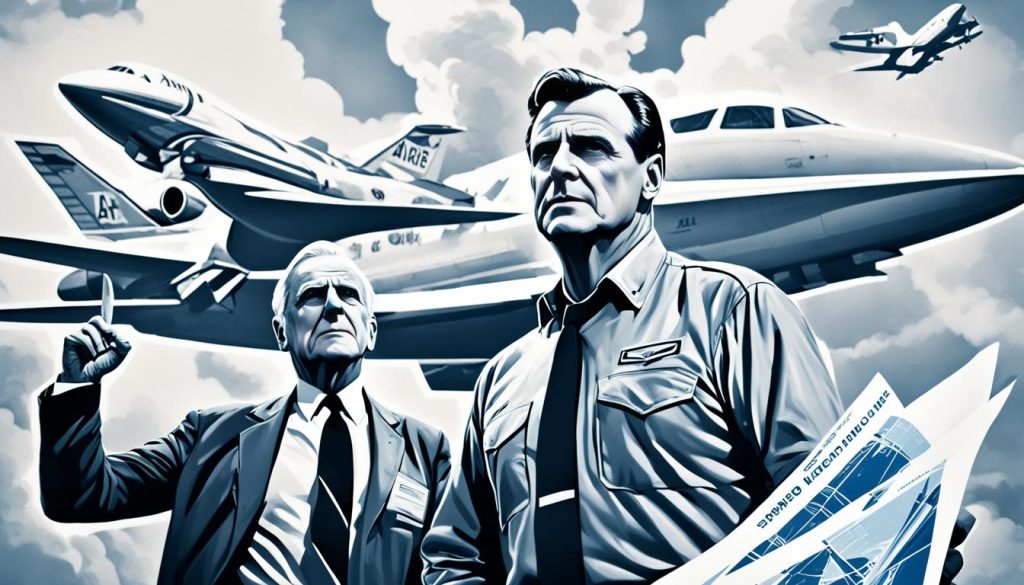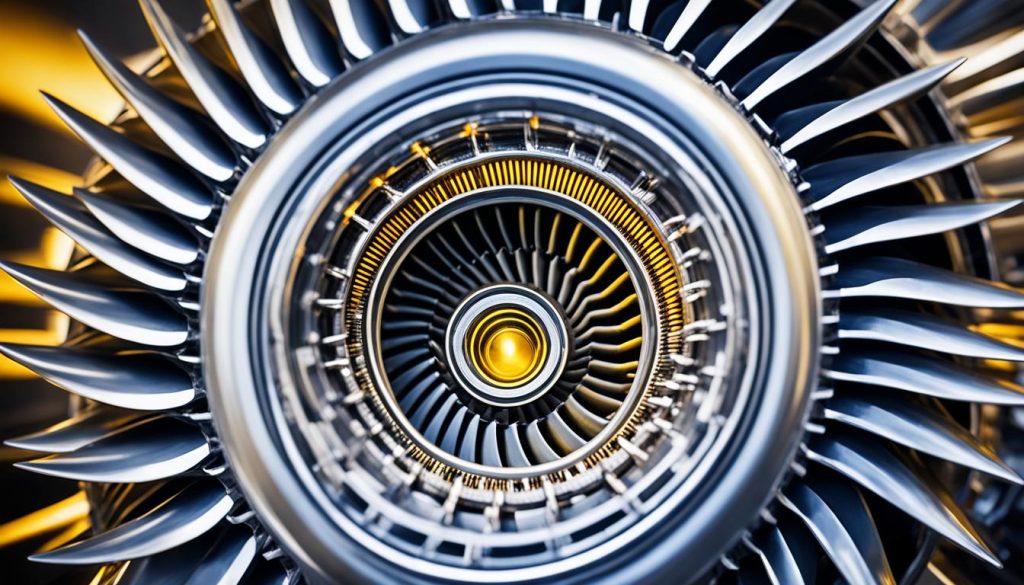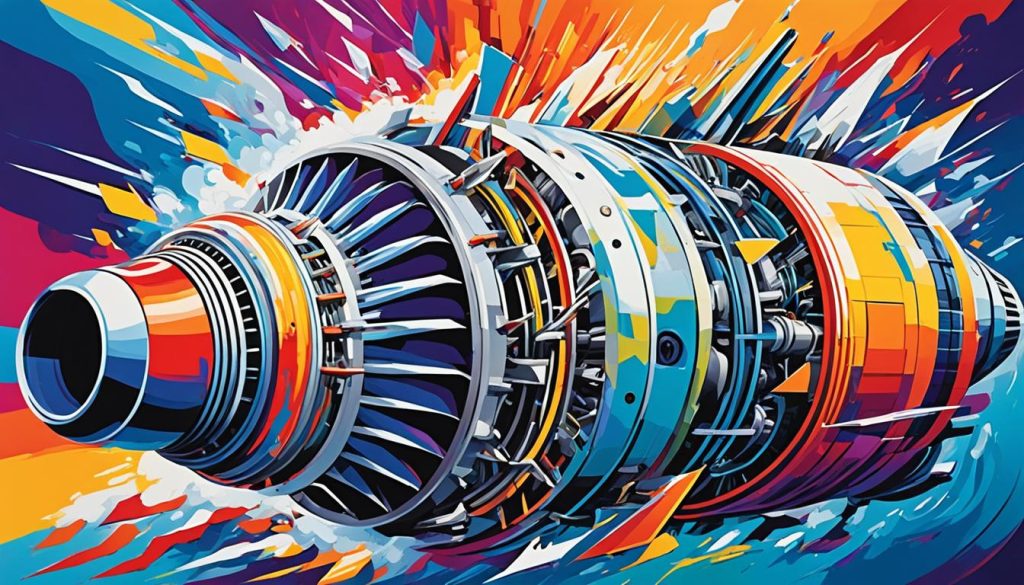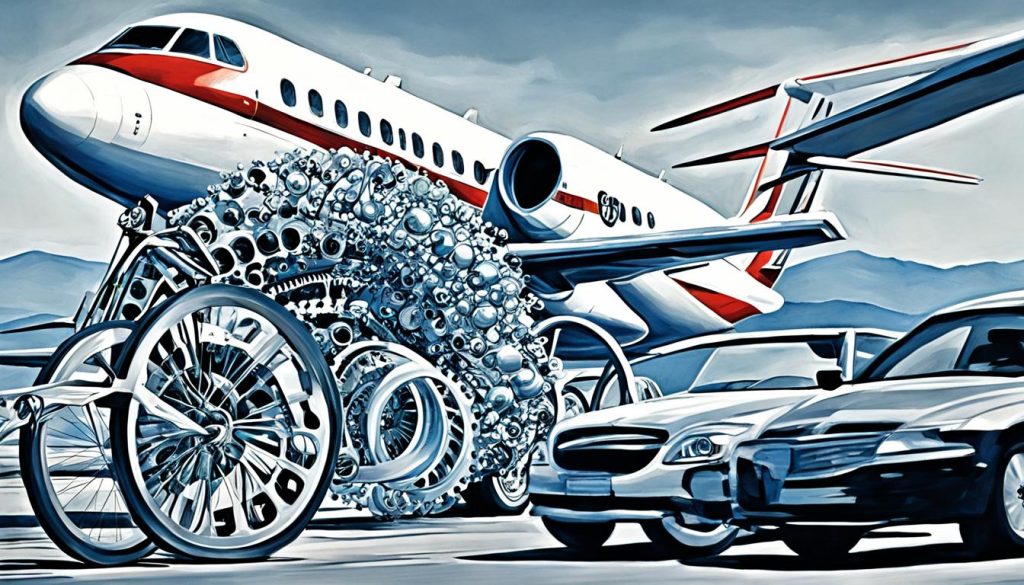Imagine standing at the start of an incredible journey. It’s where a young boy’s love for flying turns into real innovation. His room is filled with model airplanes and books, his eyes shining with dreams of soaring through the skies1.
This is where the story of changing the skies starts. It’s a story of engineering wonders that would change everything1.
From the Wright brothers’ first flight in 1903 to today’s jet age, aviation has seen amazing changes. We’ll see how engines went from pistons to jets, changing not just planes but our world too. This journey covers a century of progress, filled with brave pioneers and visionaries1.
Like Horacio Pagani, who worked on his first hypercar for nine years, jet engine creators put their hearts into their work. Their passion, starting from childhood dreams, led to big technological leaps. These leaps continue to shape our skies today2.
Key Takeaways
- Childhood fascination with flight can spark revolutionary innovations
- The evolution from piston engines to jets transformed aviation
- Pioneers in aerospace faced significant challenges and risks
- Jet engine development has impacted commercial and military sectors
- Continuous innovation drives the future of propulsion technology
The Birth of a Visionary: Early Fascination with Flight
Young minds have always been drawn to the magic of flight. How did aerospace pioneers start their journey? It often begins in childhood, with dreams fueled by simple toys and endless imagination.
Childhood Obsession with Model Airplanes
Imagine a child’s eyes lighting up at a toy helicopter. In 1878, Milton Wright gave his sons Wilbur and Orville a small model helicopter. This sparked their lifelong love for flight3. Many future pilots found their passion through model airplanes.

Unique Problem-Solving Abilities at a Young Age
Genius problem-solvers often start young. Robert H. Goddard, born in 1882, was curious about science and mechanics from a young age4. His health issues made him excel in various subjects, preparing him for his rocketry innovations.
The Influence of Aviation Books and Engineering Marvels
Books and scientific texts inspire young minds. At 16, Goddard became interested in space after reading H.G. Wells’ “The War of the Worlds”4. The Wright brothers were also inspired by Otto Lilienthal, who in 1891 designed a glider for long-distance human flight5.
“The desire to fly is an idea handed down to us by our ancestors who looked enviously on the birds soaring freely through space on the infinite highway of the air.” – Wilbur Wright
These early experiences guided future aerospace pioneers. From toy helicopters to complex math, each step fueled innovation that changed flight forever.
Pioneering Minds: Frank Whittle and Hans von Ohain
In aviation history, two men changed everything. Frank Whittle and Hans von Ohain made jet engines a reality. They worked alone but changed the sky forever.

Ever wonder how they did it? Whittle, a British Royal Air Force pilot, worked hard with a fiery spirit. Von Ohain, a German physicist, used his brain to imagine new possibilities.
Both men faced big challenges. People doubted them and didn’t see their vision. But they didn’t give up. Their hard work led to the first jet aircraft flight in 1939, a big step in aviation history6.
“Innovation is not born from comfort, but from necessity and vision.”
These pioneers show us that great ideas can come from anywhere. Whittle and von Ohain’s work, though different, led to the same amazing result. Their story teaches us that dreaming big and working hard is what counts.
Fascination to Innovation: The Journey of a Boy Who Revolutionized Jet Engines
You dream of flying high, feeling the rush of propellers. From toy planes to real jet engines, the journey is full of wonder and hard work. Imagine a young boy, eyes wide with excitement, making tiny flying machines in his backyard.
From Model Airplanes to Real Jet Engines
Your adventure starts with simple toys but grows bigger. Like the Wright brothers, you move from gliders to powered flight. In 1903, Orville Wright made a 120-foot flight in 12 seconds. Wilbur flew 852 feet in 59 seconds on the same day7. These early wins spark your dream to explore aviation’s limits.

The Path from Amateur Enthusiast to Professional Engineer
As you get older, your love for flying grows. You dive into engineering, learning about how planes work. The Wright brothers’ careful problem-solving and never giving up inspire you8. You see that success in aviation needs creativity and hard science.
Overcoming Challenges and Skepticism in the Aviation Industry
The path to new ideas is tough. You face doubt, like Samuel Langley, whose “Aerodrome” fell into the Potomac in 19038. But you keep going, inspired by pioneers who beat the odds. Your hard work in improving plane technology is like the Wright brothers’ drive for controlled flight. With many trials and strong will, you’re getting closer to changing jet engines and making your mark in aviation history.
“The desire to fly is an idea handed down to us by our ancestors who looked enviously on the birds soaring freely through space on the infinite highway of the air.” – Wilbur Wright
The Birth of the Jet Age: First Flights and Breakthroughs
You’re at the start of a new era in flying. The Wright brothers made history in 1903 with their powered flight. Their Wright Flyer I flew for 12 seconds and went 120 feet9. This was the start of big changes in flying technology.
After Kitty Hawk, flying got much better. The first solo flight across the Atlantic and the first flight with passengers happened. These big steps led to the jet age, a new chapter in flying technology.

The jet age began with the secret flight of the Heinkel He-178 on August 27, 1939, in Germany. This event changed aviation, war, and travel. In Britain, Frank Whittle worked hard and made a jet engine that worked well. This led to the Gloster E.28/39 jets.
“The sky is not the limit. There are footprints on the moon.”
Just 65 years after the Wright brothers flew, astronauts Neil Armstrong and Buzz Aldrin walked on the moon. This shows how fast flying has changed9. The Wright brothers started the modern flying era. They inspired others to keep pushing flying to new heights9.
Propulsion Systems Evolution: From Pistons to Jets
You’re at the start of a new era in aeronautics. The move from piston engines to jet propulsion is a big step forward in aviation technology. This change is one of the biggest engineering feats in flight history.
Comparing Traditional Engines to Jet Propulsion
Imagine the sound of a piston engine, then think of a jet engine’s power. Jet engines are lighter, cheaper, and use fuel better. By 1939, Whittle’s engine was running at speeds of up to 16,000 RPM, leaving piston engines behind10.

Advantages of Jet Engines in Speed and Efficiency
Jet propulsion lets planes fly higher and faster than ever. It makes long trips shorter, connecting the world in ways we couldn’t imagine before.
The Impact on Commercial and Military Aviation
Jet engines have changed aviation. They’ve made flying safer and faster for everyone. They’ve also changed how planes are made and used in both civilian and military flying.
“The jet engine is not just a leap forward; it’s a quantum jump into the future of aviation.”
Looking at these amazing planes, think about the dreamers and innovators behind each jet engine. The story of how we move forward in flight is still being written, with more exciting chapters to come.
Aeronautics Revolution: How Jet Engines Changed Aviation
You’re at the start of a new chapter in aviation history. Jet engines brought a big change, taking pioneers to new heights. This change made flying faster and more efficient.
Picture flying at speeds once thought impossible. The X-15 broke records, reaching over 4,500 miles per hour and flying higher than 100,000 feet11. This aircraft, with its powerful rocket engine, set the stage for future breakthroughs11.
From the Wright brothers’ first flight in 1903 to the X-15’s high-altitude feats, aviation has evolved greatly12. Each new technology opened up new possibilities, making the world smaller and more connected.
“The sky is not the limit; it’s just the beginning.”
Wind tunnels were key to this aviation revolution. In 1943, the Langley Research Center’s Eight-Foot High-Speed Tunnel got more powerful, helping with near-sonic speed tests13. With the “slotted-throat” change, we could better understand fast-moving air13.
Looking at today’s planes, we remember those who dared to dream big. Their work inspires us, driving the next wave of aerospace pioneers.
https://finserviceshub.com/bond-market-risk-a-comprehensive-guide-for-financial-professionals/
Technological Breakthroughs: Key Innovations in Jet Engine Design
Jet engines are true marvels of engineering, constantly pushing the limits of flight. They have evolved through a series of groundbreaking technological advancements. These changes have completely changed how we fly.
Materials Science Leaps
Materials science has been a game-changer for jet engines. Engineers now create parts that can handle extreme heat and stress. This is similar to how sharkskin swimsuits help swimmers, with most Olympic medals won by those wearing them14. These new materials let engines run hotter and work better.
Fuel Efficiency and Thrust Improvements
Jet engines have gotten much better at using fuel and producing thrust. This is like Henry Ford’s dream of making cars affordable for everyone, which led to the Model T in 190815. Now, jet engines use less fuel but still perform well, just like how Ford made cars more accessible.
Computer-Aided Design and Manufacturing
Using computers to design and make jet engines has changed how they’re made. This is similar to Ford’s innovative assembly line in 1913, which changed car production15. Today, jet engines are made with precision and efficiency, just like Ford’s team increased production to meet demand.
“Innovation is not about the tools we use, but the dreams we dare to realize.”
Thinking about these advances, imagine a future where jet engines are inspired by nature, like the manta ray designs for faster, quieter flights14. The story of jet engine innovation is far from over, with many more exciting breakthroughs on the way.
Modern Marvels: Contemporary Jet Engine Applications
Imagine flying high, thanks to engineering wonders. Today’s jet engines do more than just power planes. They’re used in many flying machines and even in new areas.
These engines power commercial planes, military jets, and drones. Each use shows how aeronautics technology is versatile. Thanks to new designs, jet engines have opened up new possibilities in the sky and beyond.
Jet engines aren’t just for flying anymore. Now, they power watercraft too. Imagine speeding on water with a handheld electric jet engine. This shows how jet technology can be used in new ways.
“The sky is not the limit. It’s just the beginning.”
Jet engines are taking us to new places, from space to the ocean. The Voyager spacecraft, running for 46 years, has explored our solar system16. On Earth, scientists use advanced engines to study our galaxy in new ways.
At Drexel University, researchers made a unique image of the Milky Way using neutrinos17. This shows how jet technology and particle physics work together in science.
These engineering feats inspire us to keep innovating. From school to space, jet propulsion drives progress in many areas18. The future of flying is endless, thanks to our imagination.
The Future of Propulsion: Emerging Technologies and Concepts
The world of aeronautics is on the edge of a new era. Propulsion systems are set for a big change. This change will completely change how we fly.
Electric and Hybrid Propulsion Systems
Imagine a sky full of quiet aircraft, leaving almost no carbon footprint. This dream is becoming real with electric and hybrid propulsion. These systems are not just ideas; they’re already flying. Satellites with all-electric propulsion are much more efficient than those using chemical fuels19.
Hypersonic Engines and Scramjets
Picture flying across continents in just hours. Hypersonic engines and scramjets will break speed limits, making fast travel common. Boeing is leading the way with hypersonic vehicles that could make space travel cheaper19. These technologies might soon make what was once science fiction a part of our daily lives.
Sustainable Aviation Fuels and Their Impact
The skies are getting greener every day. Over 1,600 flights have used biofuels and traditional kerosene. These fuels cut carbon emissions by 60-80%19. This is a big step towards cleaner air and a healthier planet.
The future of flight is not just about speed and efficiency. It’s about being responsible for our world and the future.
Looking ahead, these advancements in propulsion and aeronautics are huge. They’re not just new tech. They’re your ticket to a future where flying is just the start.
Inspiring the Next Generation: Educational Initiatives in Aerospace
You stand on the shoulders of giants, carrying a legacy of flight that started with the Wright brothers. Their first flight in 1903 was just 12 seconds long and covered 120 feet. It sparked a revolution that took us to the moon in just 65 years9. Today, aerospace pioneers keep pushing limits, inspiring young minds to aim high.
The Lawrence Sperry Award highlights young innovators under 35 who make big impacts in aeronautics or astronautics20. This award celebrates the genius in solving problems that moves the industry forward. You could be the next Phillip Ansell, who won this award in 2023 for his work on electrified aircraft technologies20.
Your path in aerospace could lead to amazing achievements. Embry-Riddle Aeronautical University helps train future leaders like Dr. John Maris, who made big strides in aviation safety. Stories of pioneers like him inspire the next generation of engineers and scientists.
The aerospace industry is always changing. In 2024, China made history by retrieving rocks from the moon’s far side, and Rocket Lab launched its 50th Electron rocket21. These achievements show the vast possibilities for you in this field. Your skills could help shape missions that explore new frontiers.
“The sky is not the limit. Your mind is.”
Educational programs in aerospace are your gateway to the stars. You can find internships at companies like Boeing or get research grants from NASA if you love flight20. Your journey could take you from designing electric aircraft to planning Mars missions. The future of aerospace is yours to shape with your creativity.
Conclusion: The Enduring Legacy of Jet Engine Pioneers
You’re at a turning point, where dreams of the sky start to take shape. The Wright brothers, once bicycle mechanics, changed aviation with their control system and wing-warping22. Their work, like a jet stream, keeps pushing us forward in aviation history.
Aerospace pioneers keep breaking new ground, from the moon to Earth’s atmosphere21. China’s moon mission and Rocket Lab’s 50th launch show our endless creativity21. These feats remind us of pioneers like Frank Whittle and Hans von Ohain, who changed flight with their jet engines.
Looking up, think about how far we’ve come from model planes to hypersonic engines. The Artemis Accords, signed by 42 nations, show our aim for the stars21. Each event, from Saudia Group’s Airbus order to Blue Origin’s flights, adds to our future in the sky21.
Your story in aerospace mirrors the pioneers’ dreams. With eVTOL aircraft and space exploration, the legacy of jet engine pioneers keeps inspiring us. Their vision pushes us towards new horizons in human achievement.

